Source Article Here
Radiofrequency Radiation: A Significant Factor in Increasing Thyroid Cancer?
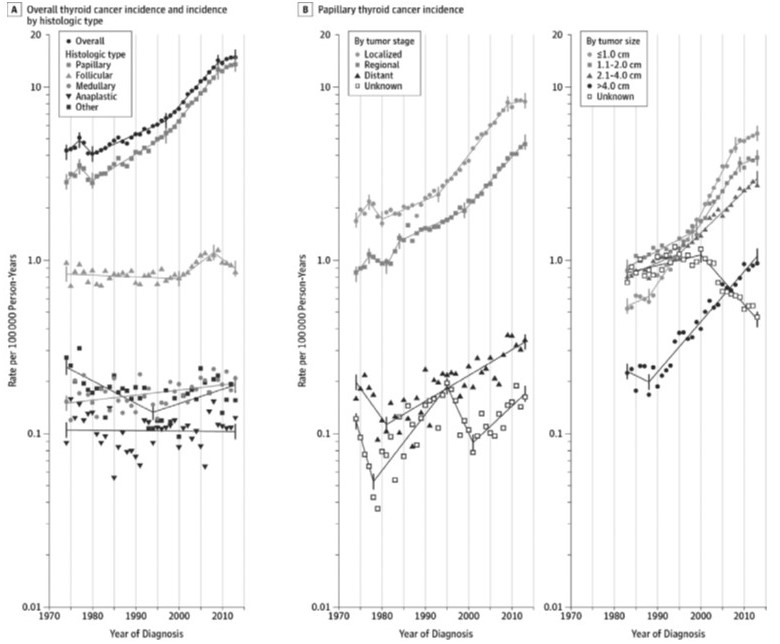
The incidence of thyroid cancer has nearly tripled over the last thirty years, both in the United States and around the world. In fact, thyroid cancer incidence has been rising so fast that it is expected to become the number four cancer worldwide by 2030.1 In a 2017 study that showed a 3 percent annual increase in U.S. thyroid cancer incidence from 1974 to 2013, the authors concluded that their findings were “consistent with a true increase in the occurrence of thyroid cancer in the United States.”2
The study also showed that the rise in thyroid cancer is mainly due to increases in papillary thyroid cancer, a type of cancer that arises in the follicular cells that produce and store thyroid hormones.3 Roughly four in five thyroid cancers are papillary thyroid cancers.4 Figure 1 (next page) shows how the incidence of thyroid cancer overall and papillary thyroid cancers in the U.S. steadily increased from 1974 to 2013.
Cell Phones and the Thyroid
According to the authors of a 2013 study published in the Journal of the American Medical Association, the increased incidence of thyroid cancer cannot be attributed to overdiagnosis (that is, improved diagnostic methods or more screening) but instead is likely due to environmental factors.5 In particular, a growing body of scientific evidence from human and animal studies shows thyroid damage from the non-ionizing radiofrequency (RF) radiation produced by cell phones and Wi-Fi. Scandinavian researchers have pointed out that papillary thyroid cancers are particularly sensitive to radiation.6
Nearly all American adults (97 percent) now own a cell phone.7 In 2019, Yale researchers reported elevated risks of thyroid cancer among heavier, long-term cell phone users.8Individuals were at greater risk of thyroid cancer if they used a cell phone for more than fifteen years, for more than two hours per day or for a greater number of lifetime hours, and those who had made the most cell phone calls in their lifetime were also at increased risk. Men who had used cell phones for over fifteen years had more than twice the thyroid cancer risk as cell phone non-users; women who used cell phones more than two hours per day had a 52 percent greater risk of thyroid cancer compared to cell phone non-users.

In another study published by some of the same Yale researchers in early 2020, the study team found that individuals with certain genetic variations had more than twice the risk of thyroid cancer from cell phone use as people without the genetic variation.9 After examining a total of one hundred seventy-six genes, the researchers identified ten variations (single nucleotide polymorphisms or SNPs) that appear to increase the risk of thyroid cancer among cell phone users to a statistically significant degree (p < 0.01).
In late 2018, the U.S. government’s National Toxicology Program (NTP) published results of a two-year cell phone radiation study in rats and mice. The NTP designed the study to assess cancer risks and other potential health hazards resulting from exposure to 2G and 3G cell phone radiation.10 These earlier generations relied on network technology called GSM (Global System for Mobiles) or CDMA (Code Division Multiple Access). The NTP investigators measured a statistically significant increased incidence of C-cell hyperplasia (abnormal overgrowth of cells) in female rats exposed to GSM-modulated RF radiation, and also observed an increased incidence of C-cell hyperplasia (not reaching statistical significance) in male rats in the lowest exposure group (1.5W/kg). Many researchers consider C-cell hyperplasia in humans to be a precursor of a hereditary form of thyroid cancer called medullary thyroid carcinoma,11 and some speculate that the hyperplasia may also precede other types of thyroid cancer.6
Examining the nearly half-century period from 1970–2017, Scandinavian researchers found a statistically significant increased incidence of thyroid cancer over time in both Swedish and Nordic women and men (Figures 2 and 3).6 Again confirming that this steep increase in thyroid cancer is not due to overdiagnosis, these researchers postulated that the increased incidence could be due to cell phones as well as DECT (Digital Enhanced Cordless Telecommunications) cordless phones.
For Swedish women, whereas the average annual percentage increase was 2.13 percent overall, the change from 2010 through 2017—an annual percentage increase of 9.65 percent— was especially pronounced. For Swedish men, the average annual percentage rose by 1.49 percent over the forty-seven year period, but the highest annual percentage increase (5.26 percent) was observed from 2001–2017. The results for 1970–2016 were similar for all Nordic countries, but again, the greatest increases were in the most recent decade examined: 5.83 percent in women (2006–2016) and 5.48 percent in men (2005–2016).6
Concluding that their results “do definitely indicate an etiologic impact of an exogenous cancer-causing factor with increasing exposure over time,” the researchers pointed to the timeline of wireless phones’ rollout in Nordic countries (beginning with the first mobile and DECT phones in the 1980s), suggesting that the RF radiation from handheld phones should be a prime suspect.6 They noted that the phones’ antenna position “gives RF exposure to the thyroid gland”—one of the highest exposed organs other than the brain—and the phones, in addition, “give off RF radiation to the head and neck region.” Finally, observing the relatively short five-to-ten-year latency period for thyroid cancers induced by ionizing radiation (such as that produced by X-rays), the authors suggested that there could be a roughly comparable latency period (less than thirteen years) for thyroid cancers associated with the non-ionizing RF radiation from handheld phones.
Wireless Trends
The continuing steep rise in the incidence of thyroid cancer—with no plateau in sight—indicates that the environmental factor responsible for the cancers also has not plateaued. It is a fact that use of wireless technology has grown steadily since cell phone and cordless phone use began in the 1980s, to the point where nearly all adults and most children in the United States use cell phones and other wireless devices. Tablets and laptop computers have also proliferated, becoming ubiquitous after Wi-Fi was made available to consumers in 1997.
The continuous increase in cell phone subscribers requires a corresponding increase in cell phone towers to provide cell phone service. According to the 2020 annual survey conducted by the wireless industry trade group, CTIA, the number of U.S. cell towers more than tripled between 2001 and 2019, going from roughly one hundred twenty-seven thousand to over three hundred ninety-five thousand.12
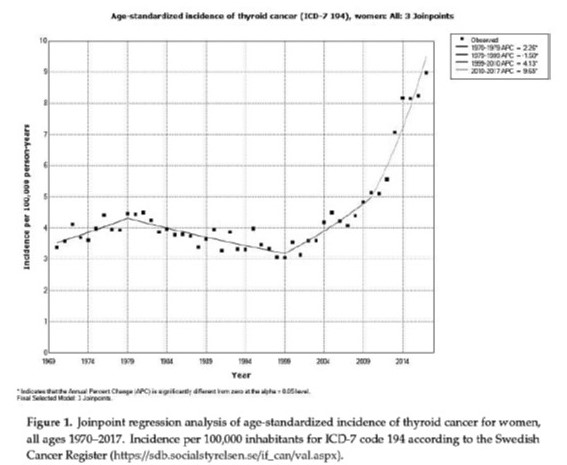
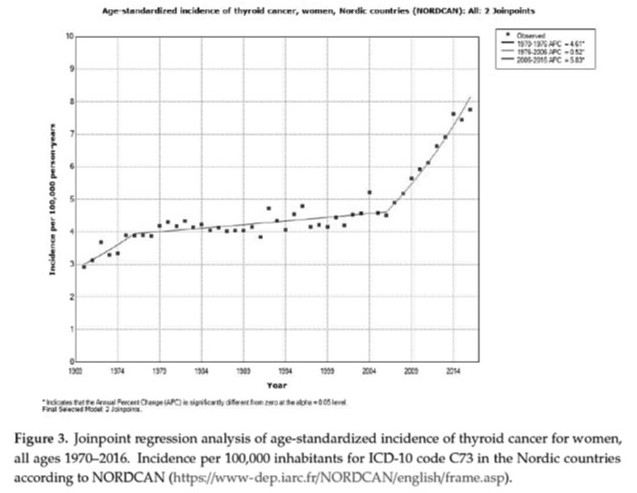
In addition to the cell towers, the home environment has changed dramatically. Around 2014, for example, the practice of embedding public Wi-Fi hot spots into residential modem/routers began; there are now at least eighteen million Wi-Fi hot spots in U.S. homes and businesses.13In addition, other wireless devices (such as baby monitors) have become commonplace, while “smart” wireless devices began proliferating with the introduction of the “smart” TV in 2008. We now see wireless doorbell and security systems, wireless personal assistants, “smart” meters, “smart” appliances and, inevitably, “smart” homes. On the road, radar on cars was introduced in the early 1990s and has now become a standard car feature. Wireless wearables have also become popular, including wireless watches, wireless fitness trackers and wireless medical monitors.
In 2019, we saw the introduction of 5G, which is intended to connect everything and everyone to the Internet of Things (with the Internet of Bodies soon to follow). 5G requires the addition of several times more antennas, called “small cells,” which are being placed on streetlights and utility poles within a few meters of residences and within a few feet of pedestrians. In many urban areas, the 5G rollout relies on the millimeter-wave portion of the spectrum (formerly allocated primarily to the military)—shorter wavelengths that do not travel far or penetrate buildings as well—while in rural areas, 5G uses lower frequency bands (600 and 700 MHz) not subject to those constraints. For both portions of the spectrum, the operating environment for 5G involves health-damaging pulsing and modulation of the carrier signal and the potential for wireless radiation to produce adverse effects synergistically with chemical and biological toxins.14 Moreover, 6G—where “biology meets Artificial Intelligence”—is on the way,15 along with other AI-related technologies such as RF chips implanted in the brain.16
In addition to RF EMFs, extremely low frequencies (ELF) from 3 to 3000 Hz are emitted by all wireless communications in the form of pulsing and modulation. There is significant evidence that some of the principal adverse effects on living organisms from wireless technologies are from the ELF pulsing and modulation.14
Human and Animal Studies
As already mentioned, many human and animal studies show thyroid damage from cell phone and Wi-Fi radiation. In one study published in 2012, which followed participants for six years, the researchers found long-term effects on thyroid and other hormones from both cell phone use and residence within five hundred meters of a cell tower.17Individuals with long-term exposure to these forms of RF radiation displayed statistically significant decreases (p<0.01) in thyroid hormones T3 and T4, the adrenal gland hormones ACTH and cortisol, and sex hormones progesterone and testosterone compared to unexposed individuals.
In a study involving medical students in South India, researchers identified a statistically significant correlation between total cell phone radiation exposure and increased thyroid-stimulating hormone (TSH) (p=0.025).18
A 2009 study with similar results found higher-than-normal TSH levels among university medical students who used cell phones versus normal TSH levels in students who did not use cell phones—a difference that, again, was statistically significant (p<0.05).19
In 2015, Spanish researchers studied changes in thyroid gland morphology in rats following 2.45 GHz radiofrequency exposures of thirty minutes, assessing changes after just one exposure and also after ten repeated exposures over a two-week period.20 2.45 GHz is the carrier frequency commonly used in Wi-Fi. The exposures were below thermal levels and under the U.S. Federal Communications Commission’s (FCC’s) exposure limit, which is defined as a specific absorption rate (SAR) limit of 1.6 watts per kilogram (W/kg) averaged over one gram of tissue.
The changes affected the gene expression of heat shock protein 90 (HSP-90) in the thyroid gland. Cells make heat shock proteins as a protective mechanism when the cells are exposed to temperatures above their normal growth temperature or to other stressful conditions. HSP-90 plays a “modulatory role against thyroid cancer”; in the study, as RF exposures increased, the expression of HSP-90 decreased.20
The study found statistically significant increases in the diameters of the follicular cells of exposed thyroid glands—at 0.076 + 0.0041 W/kg SAR over one gram of thyroid tissue, which is well under the FCC’s SAR limit of 1.6 W/kg—compared to unexposed thyroid cells. When compared to nonradiated animals, the rats subjected to single and repeated exposure displayed statistically significantly increased peripheral follicular diameters (p = 0.008 and p = 0.043, respectively) (Figure 4).20
Multiple Frequencies
Earlier studies have produced similar findings. Turkish researchers found in 2010 that exposing rats to pulse-modulated 900 MHz cell phone radiation (at a SAR of 1.35 W/kg) for twenty minutes per day for three weeks caused pathological changes in the thyroid gland by altering the gland structure and inducing hypothyroidism, inhibiting thyroid hormone secretion.21 (Cell phones sold in the U.S. cannot exceed a SAR rating of 1.6 W/kg.) The RF-exposed rats had higher follicle diameters in their thyroid glands compared to sham-exposed and cage-control rats (p<0.001) and higher colloid diameters (p<0.001). The researchers hypothesized that reactive oxygen species (ROS) generation and overload of cellular calcium ions could be involved in altering thyroid morphology and inducing pathways in thyroid cells involving caspases (protease enzymes that play a major role in programmed cell death). In a 2006 study, Swedish and Serbian investigators found changes in thyroid tissue from exposure to ELF frequencies of 50 Hz (Figure 5).22
Indiscriminate Use
RF radiation in the environment has increased exponentially over the last thirty years. It will to continue to do so as long as the majority of people remain unaware of its non-thermal health effects and continue to use wireless technologies indiscriminately.
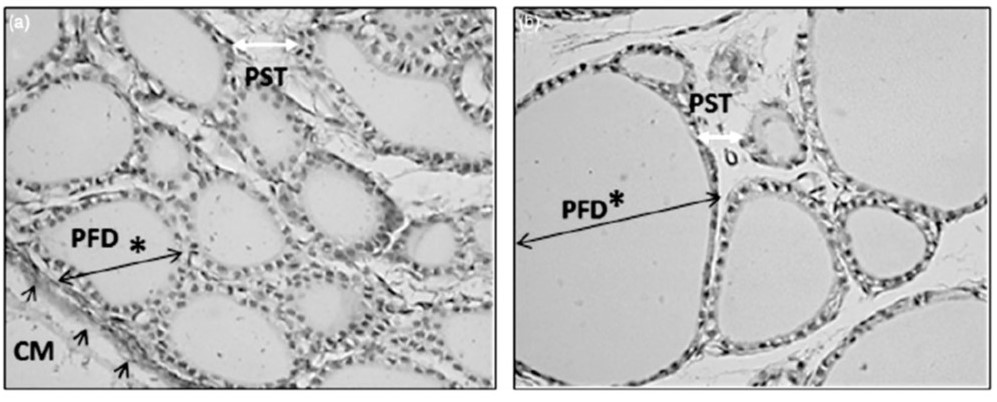
SIDEBAR
Thyroid Cancer in Children
In the U.S., as in many countries, cell phone use starts young.25 Over half (53 percent) of U.S. children have a smartphone by age eleven, and 84 percent of American adolescents own one.26 Noting that children are also exposed “involuntarily” to multiple types of non-ionizing radiation from electromagnetic fields (EMFs) in their daily life, one group of authors wrote about EMFs in 2015, “there are unignorable amount of studies indicating the increased risk of cancer, hematologic effects and cognitive impairment,” as well as “impacts on metabolism and endocrine function.”27 Raising concerns about the “detrimental effects of EMFs on thyroid functions, adrenal hormones, glucose homeostasis and melatonin levels,” these authors pessimistically concluded, “there is growing evidence to distress us about the threats of EMF on children.”
It is perhaps unsurprising, then, that thyroid cancer is the fastest growing cancer in children. According to a 2018 presentation by Centers for Disease Control and Prevention (CDC) researchers, five different types of cancer displayed increased incidence in young people under age twenty from 2001 to 2014, but thyroid cancers were the standout.28Pediatric thyroid cancers increased on average 4.8 percent per year over that period, versus a 2.5 percent average annual increase for liver cancers, 1.2 percent for non-Hodgkin lymphomas, 0.6 percent for kidney tumors and 0.4 percent for central nervous system cancers. The average annual rate of increase over that period for pediatric cancers overall was 0.7 percent.
References
- Rahib L, Smith BD, Aizenberg R, et al. Projecting cancer incidence and deaths to 2030: the unexpected burden of thyroid, liver, and pancreas cancers in the United States. Cancer Res. 2014;74(11):2913-2921.
- Lim H, Devesa SS, Sosa JA, et al. Trends in thyroid cancer incidence and mortality in the United States, 1974-2013. JAMA. 2017;317(13):1338-1348.
- https://www.mayoclinic.org/diseases-conditions/thyroid-cancer/symptoms-causes/syc-20354161
- https://columbiasurgery.org/conditions-and-treatments/papillary-thyroid-cancer
- Yoo F, Chaikhoutdinov I, Mitzner R, et al. Characteristics of incidentally discovered thyroid cancer. JAMA Otolaryngol Head Neck Surg. 2013;139(11):1181-1186.
- Carlberg M, Koppel T, Hedendahl LK, Hardell L. Is the increasing incidence of thyroid cancer in the Nordic countries caused by use of mobile phones? Int J Environ Res Public Health. 2020;17(23):9129.
- Mobile fact sheet. Pew Research Center, Apr. 7, 2021. https://www.pewresearch.org/internet/fact-sheet/mobile/
- Luo J, Deziel NC, Huang H, et al. Cell phone use and risk of thyroid cancer: a population-based case-control study in Connecticut. Ann Epidemiol. 2019;29:39-45.
- Luo J, Li H, Deziel NC, et al. Genetic susceptibility may modify the association between cell phone use and thyroid cancer: a population-based case-control study in Connecticut. Environ Res. 2020;182:109013.
- https://ntp.niehs.nih.gov/whatwestudy/topics/cellphones/index.html
- Canberk S. Precursor and borderline lesions of the thyroid (indolent lesions of epithelial origin): from theory to practice. Gland Surg. 2020;9(5):1724-1734.
- 2020 Annual Survey Highlights. CTIA, Aug. 25, 2020. https://www.ctia.org/news/report-2020-annual-survey-highlights
- https://www.xfinity.com/mobile/support/article/xfinity-mobile-wifi-hotspots
- Kostoff RN, Heroux P, Aschner M, Tsatsakis A. Adverse health effects of 5G mobile networking technology under real-life conditions. Toxicol Lett. 2020;323:35-40.
- Fisher T. 6G: What it is & when to expect it. Lifewire, Oct. 1, 2021.
- Schumaker E. Elon Musk unveils brain chip implant: “It’s like a Fitbit in your skull.” Yahoo!News, Aug. 29, 2020.
- Eskander EF, Estefan SF, Abd-Rabou AA. How does long term exposure to base stations and mobile phones affect human hormone profiles? Clin Biochem. 2012;45(1-2):157-161.
- Baby NM, Koshy G, Mathew A. The effect of electromagnetic radiation due to mobile phone use on thyroid function in medical students studying in a medical college in south India. Indian J Endocrinol Metab. 2017;21(6):797-802.
- Mortavazi S, Habib A, Ganj-Karami A, et al. Alterations in TSH and thyroid hormones following mobile phone use. Oman Med J. 2009;24(4):274-278.
- Misa-Agustiño MJ, Jorge-Mora T, Jorge-Barreiro FJ, et al. Exposure to non-ionizing radiation provokes changes in rat thyroid morphology and expression of HSP-90. Exp Biol Med (Maywood). 2015;240(9):1123-1135.
- Eşmekaya MA, Seyhan N, Ömeroğlu S. Pulse modulated 900 MHz radiation induces hypothyroidism and apoptosis in thyroid cells: a light, electron microscopy and immunohistochemical study. Int J Radiat Biol. 2010;86(12):1106-1116.
- Rajkovic V, Matavulj M, Johansson O. Light and electron microscopic study of the thyroid gland in rats exposed to power-frequency electromagnetic fields. J Exp Biol. 2006;209(Pt 17):3322-3328.
- Moskowitz JM. Thyroid cancer & mobile phone use. Electromagnetic Radiation Safety, Sep. 29, 2021. https://www.saferemr.com/search?q=thyroid
- Physicians for Safe Technology. Head and neck tumors. Updated 01/09/20. https://mdsafetech.org/head-and-neck-tumors/
- Carpenter DO. Electromagnetic fields and cancer: the cost of doing nothing. Rev Environ Health. 2010;25(1):75-80.
- Kamenetz A. It’s a smartphone life: more than half of U.S. children now have one. NPR, Oct. 31, 2019.
- Sangün Ö, Dündar B, Çömlekçi S, Büyükgebiz A. The effects of electromagnetic field on the endocrine system in children and adolescents. Pediatr Endocrinol Rev. 2015;13(2):531-545.
- Siegel D, Li J, Henley J, et al. Incidence rates and trends of pediatric cancer — United States, 2001–2014. 2018 Conference of the American Society of Pediatric Hematology/Oncology, Poster #605, pp. 259-260. http://aspho.org/uploads/meetings/2018annualmeeting/Abstracts_for_Website.pdf
This article appeared in Wise Traditions in Food, Farming and the Healing Arts, the quarterly journal of the Weston A. Price Foundation, Winter 2021
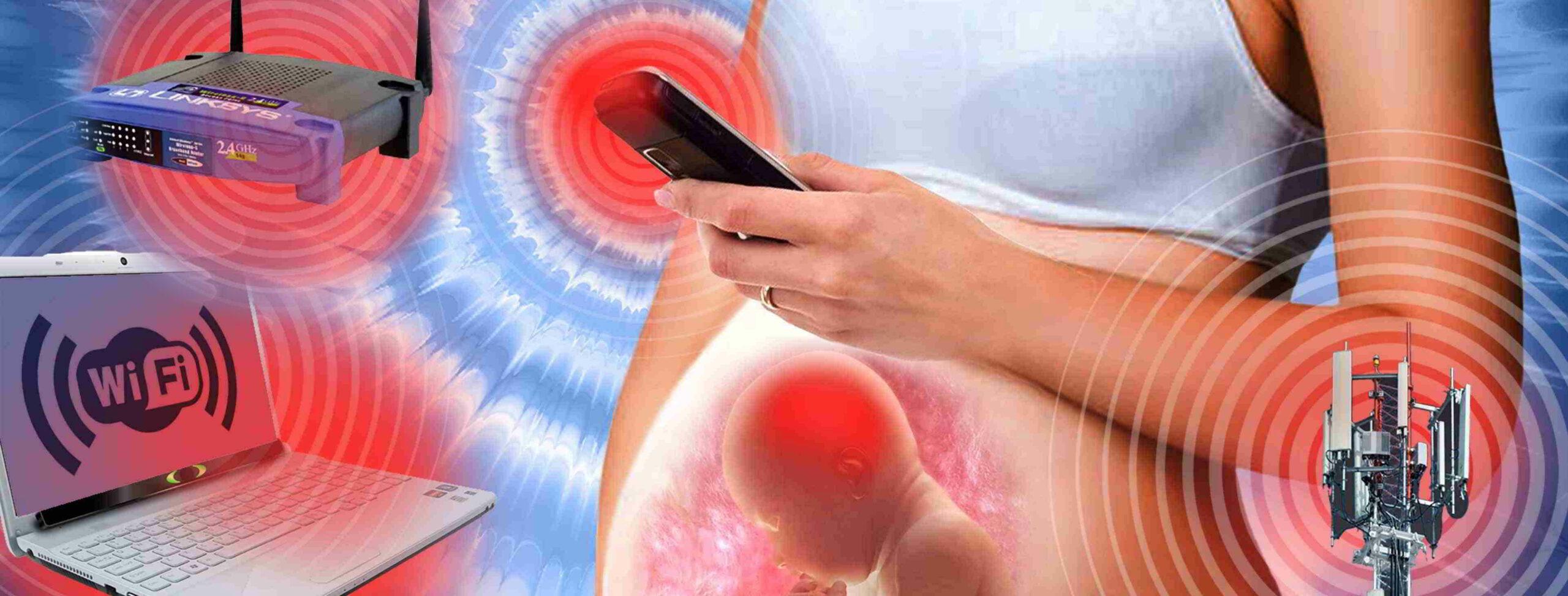
Great article, thanks for posting. I have tried for the past 2 years to convince my friends and family members to ditch cellphones and Wi-fi like me. So far not a single convert! I’m typically met with an air of animosity, and that’s with me being polite, on best behavior.
The Bible says our lives are short, like a vapor. Praise God that as Christians, we have the blessed assurance of eternity in heaven. We overcome by the righteous blood of Jesus Christ and the Word of His Testimony!! God Bless.
Yes Caleb. Most people are very reluctant to change. They are addicted to their wireless devices and their nervous systems are habituated to the luciferian frequencies. Their lives are in great danger, as are the lives of their children, pets, and all living things in their environment.
I am glad that strong Christian belief is helping you. Thanks for your comment.